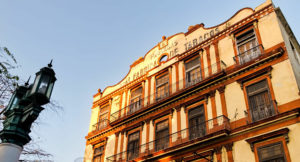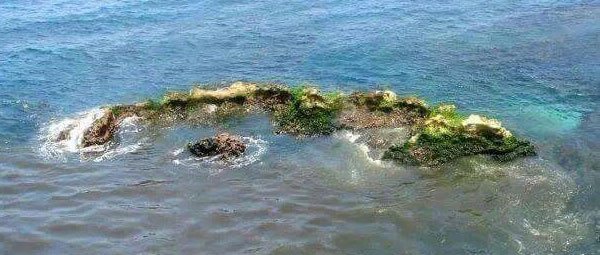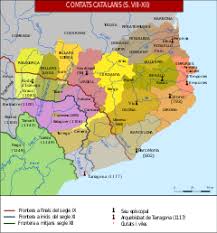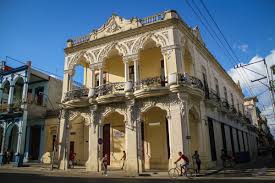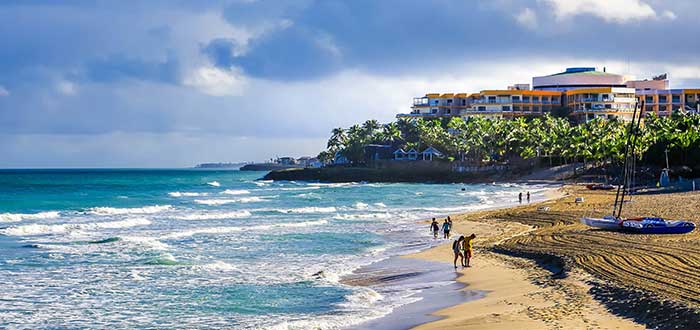
CATALUÑA Y CUBA: UNA IMPORTANTE HERENCIA POCO CONOCIDA.
BACARDÍ, PARTAGÁS, SARRÁ Y GELATS. Diferentes apellidos que triunfaron como importantes marcas cubanas: ron, tabaco, la industria farmacéutica e incluso el sistema bancario. Desde el siglo XVIII, el sello catalán de la inmigración en el país ha sido un referente en casi todos los sectores de la economía, así como en la cultura, la arquitectura y la política social.
La historia indica que fue en Cuba donde se diseñó la famosa bandera independentista catalana y donde también se redactó la primera Carta Magna de la provincia. Así de fuerte es el vínculo entre los catalanes y la isla. Por otro lado, los expertos también aseguran que el modernismo europeo llegó al país, en gran parte, gracias a la influencia catalana.
LOS CATALANES CELEBRAN EN CUBA
En los siglos XIX y XX, nombres como Narciso Gelats (1845-1929), fundador de la firma Gelats, una de las instituciones financieras más antiguas de la nación caribeña, y Jaime Partagás, propietario de la Real Fábrica de Tabacos de Partagás, cuya marca La Flor de Tabacos Partagás, registrada en 1845, es uno de los líderes en el mercado internacional de puros.
También los hermanos Juan y José Crusellas, quienes fundaron una de las empresas más antiguas del país en 1863, dedicada a la producción y venta de productos de higiene. Por esa época don Facundo Bacardí, procedente de la localidad Sitges en Barcelona, fabricaba un ron de calidad y añadía su firma a cada una de las botellas en Santiago de Cuba. Bautizado como Ron Bacardí, la bebida resultó la más popular de la Mayor de las Antillas.
El Cine Payret, situado en la calle Prado de la urbe capitalina, fue inaugurado en 1877 por los catalanes Joaquín Payret y Fidel Luna. La historiografía apunta que, a comienzos del siglo XX, la droguería La Reunión, ubicada en La Habana y propiedad del catalán José Sarrá, era la más grande de América Latina.
De Cuba para España llevaban tabaco, ron, azúcar morena y café. Procedentes de Cataluña venían, sobre todo, telas, vinos, aceite de olivas y otros productos típicos con demanda en la Isla. En esos años, ser catalán era sinónimo de comerciante y emprendedor. Incluso, cuando los cubanos iban a comprar en una tienda decían: “voy al catalán”
En el sitio que hoy ocupa el Memorial José Martí estuvo la primera ermita de los catalanes en Cuba, inaugurada en 1921
Angelina, una de las descendiente de la familia Soler, evoca, que en su actual provincia de su residencia los catalanes “como buenos católicos” buscaron un emplazamiento para edificar un santuario dedicado a su patrona: la Virgen de Montserrat. Inspirados en su paisaje natal, decidieron construirla en las Alturas de Simpson, una zona elevada de la ciudad con el Valle del Yumurí a sus pies. La construcción de la ermita concluyó en diciembre de 1875 y para conmemorar la fecha cada primer domingo de ese mes los matanceros iban en romería desde la Plaza de la Libertad hasta el sitio.
En La Habana, por su parte, las asociaciones catalanas proyectaron la edificación de una iglesia consagrada a la santa patrona en la otrora Loma del Tadino, bautizada después como Loma de los Catalanes o de Montserrat. Su primera ubicación fue en el sitio donde, actualmente, está el Memorial José Martí en la Plaza de la Revolución de La Habana. La ermita fue inaugurada en 1921 y demolida tres décadas más tarde. El emplazamiento definitivo es cercano a la Avenida de Rancho Boyeros, en la capital cubana.
Historiadores apuntan que su arquitectura recuerda a la de la Iglesia Nostra Senyora de l’ Esperança de S’ Agaró, localidad situada a 110 km al noreste de Barcelona. Los arquitectos fueron los catalanes Vicente J. Sallés y Francisco G. Padilla, quienes tuvieron en cuenta el clima de la nación caribeña para la creación de ese templo similar al de España.
PRIMERA SOCIEDAD BENEFICA DE AMERICA LATINA
Desde mediados del siglo XIX coexistían en Cuba las Sociedades de Beneficencia por regiones españolas. Entre ellas, la catalana, constituida definitivamente el primero de agosto de 1841; la gallega, establecida el 31 de diciembre de 1871 y la vasco-navarra, conformada el 30 de junio de 1877.
La primera de ellas fue fundada por los comerciantes José Gener y Guash y Antonio Font, y Francisco Ventosa Soler fue su primer presidente. Los objetivos de la institución fueron ofrecer atención médica, vejez asegurada y un sepulcro digno a los coterráneos en desgracia; así como repatriar a los paisanos si fuere necesario y aliviar calamidades en ambas tierras.
La colonia de catalanes también fundó, en la década de 1880, la Sociedad de recreo La Colla de Sant Mus. El local se encontraba en Galiano esquina a Neptuno y contaba con ocho salones, donde daban bailes, fiestas y juegos lícitos. Su primer presidente fue Ventura Trotcha, propietario del hotel de igual nombre situado en el Vedado.
El compendio de materiales bibliográficos, la mayoría perteneciente al otrora Centro Catalán, incluye varios ejemplares de la revista La Nueva Cataluña, cuyas páginas describen la sociedad cubana de los siglos XIX y las primeras décadas del XX. De igual manera, el centro compendia cartas que los emigrados enviaban a sus familias y cientos de volúmenes referidos a temas como filosofía, religión y artes plásticas en idioma catalán.
Rosich refiere además que dentro de las filas de la Sociedad aún permanecen ancianos reconocidos como niños de la guerra. “Algunos de nuestros afiliados de más de 80 años llegaron al país muy pequeños, exiliados como consecuencia de la Guerra Civil Española. Sus hijos, nietos y bisnietos también son nuestros socios”, advierte.
Si bien la presencia de los hijos de esa región en estadísticas resulta muy por debajo de otras regiones españolas, su influencia desde mediados del siglo XIX en los territorios de ultramar, determina que, a juicio de algunos historiadores, las colonias, entre ellas Cuba, eran económicamente más catalanas.
CATALONIA AND CUBA: AN LITTLE KNOWN IMPORTANT HERITAGE.
BACARDÍ, PARTAGÁS, SARRÁ, AND GELATS. Different surnames that triumphed as important Cuban brands: rum, tobacco, the pharmaceutical industry, and even the banking system. Since the 18th century, the Catalan stamp of immigration in the country has been a benchmark in almost all sectors of the economy, as well as in culture, architecture, and social policy.
History indicates that it was in Cuba where the famous Catalan independence flag was designed and where the first Magna Carta of the province was also drawn up. That is how strong the bond between the Catalans and the island is. On the other hand, experts also assure that European modernism came to the country, in large part, thanks to the Catalan influence.
CATALANS CELEBRATE IN CUBA
In the 19th and 20th centuries, names such as Narciso Gelats (1845-1929), founder of the Gelats firm, one of the oldest financial institutions in the Caribbean nation, and Jaime Partagás, owner of the Royal Tobacco Factory of Partagás, whose La Flor de Tabacos Partagás brand, registered in 1845, is one of the leaders in the international cigar market.
Also, the brothers Juan and José Crusellas, who founded one of the oldest companies in the country in 1863, dedicated to the production and sale of hygiene products. At that time, Don Facundo Bacardí, from the Sitges town in Barcelona, made quality rum and added his signature to each of the bottles in Santiago de Cuba. Baptized as Rum Bacardi, the drink was the most popular in the Greater Antilles.
The Payret Cinema, located on Prado Street in the capital city, was inaugurated in 1877 by the Catalans Joaquín Payret and Fidel Luna. Historiography indicates that, at the beginning of the 20th century, the La Reunion drugstore, located in Havana and owned by the Catalan José Sarrá, was the largest in Latin America.
From Cuba to Spain they carried tobacco, rum, brown sugar, and coffee. From Catalonia came, above all, fabrics, wines, olive oil, and other typical products in demand on the island. In those years, being Catalan was synonymous with merchant and entrepreneur. Even when Cubans went to buy in a store they said: “I’m going to Catalan.”
The site that today occupies the José Martí Memorial was the first hermitage of the Catalans in Cuba, inaugurated in 1921
Angelina, one of the descendants of the Soler family, recalls that in her current province of residence, the Catalans “like good Catholics” sought a location to build a sanctuary dedicated to her patron: the Virgin of Montserrat. Inspired by her native landscape, they decided to build it in the Simpson Heights, an elevated area of the city with the Yumurí Valley at the foot of it. The construction of the hermitage concluded in December 1875 and to commemorate the date every first Sunday of that month the people from Matanzas went on a pilgrimage from the Plaza de la Libertad to the site.
In Havana, for their part, the Catalan associations planned the construction of a church consecrated to the patron saint in the former Loma del Tadino, later baptized as Loma de Los Catalanes or Montserrat. Its first location was on the site where the José Martí Memorial currently stands in the Plaza de la Revolución in Havana. The hermitage was inaugurated in 1921 and demolished three decades later. The definitive location is close to Avenida de Rancho Boyeros, in the Cuban capital.
Historians point out that its architecture is reminiscent of that of the Iglesia Nostra Senyora de l ’Esperança de S’ Agaró, a town located 110 km northeast of Barcelona. The architects were the Catalans Vicente J. Sallés and Francisco G. Padilla, who took into account the climate of the Caribbean nation for the creation of this temple similar to that of Spain.
FIRST CHARITY SOCIETY OF LATIN AMERICA
Since the middle of the 19th century, the Sociedades de Beneficencia coexisted in Cuba by Spanish regions. Among them, the Catalan definitively constituted on August 1, 1841; the Galician, established on December 31, 1871, and the Basque-Navarre, formed on June 30, 1877.
The first of them was founded by merchants José Gener y Guash and Antonio Font, and Francisco Ventosa Soler was its first president. The objectives of the institution were to offer medical attention, assured old age and a dignified grave to the countrymen in disgrace; as well as repatriate the countrymen if necessary and alleviate calamities in both lands.
The colony of Catalans also founded, in the 1880s, the Recreation Society La Colla de Sant Mus. The place was located in Galiano corner to Neptuno and had eight rooms, where they gave dances, parties, and legal games. Its first president was Ventura Trotcha, owner of the hotel of the same name located in Vedado.
The compendium of bibliographic materials, the majority belonging to the former Catalan Center, includes several copies of the magazine La Nueva Cataluña, whose pages describe Cuban society in the 19th and early 20th centuries. In the same way, the center compiles letters that the emigrants sent to their families and hundreds of volumes referring to subjects such as philosophy, religion, and plastic arts in Catalan.
Rosich also refers that within the ranks of the Society there are still elders recognized as children of war. “Some of our affiliates over 80 years old came to the country very young, exiled as a result of the Spanish Civil War. Their children, grandchildren, and great-grandchildren are also our partners,” he warns.
Although the presence of the children of that region in statistics is far below that of other Spanish regions, their influence in overseas territories since the mid-19th century determines that, in the opinion of some historians, the colonies, including Cuba, were economically more Catalan.
Agencies/ Sputnik/ Danay Galletti Hernández/ Extractos/ Excerpts/ Internet Photos/ www.TheCubanHistory.com
THE CUBAN HISTORY, HOLLYWOOD.



 CATALONIA AND CUBA: a Little Known Important Heritage. Photos. * CATALUÑA Y CUBA: una Importante Herencia Poco Conocida. PHOTOS.
CATALONIA AND CUBA: a Little Known Important Heritage. Photos. * CATALUÑA Y CUBA: una Importante Herencia Poco Conocida. PHOTOS.

